Do you have outdated stained cabinets that make your kitchen feel stuck in the past? I've been there! We wanted to modernize our farmhouse kitchen, but a full gut renovation just wasn't in the budget. Luckily, our cabinets were still structurally sound and the layout worked for us.
We discovered that with the right products and techniques, paint can completely transform kitchen cabinets without endless sanding or stripping. Thanks to advances in specialty cleaners, primers and paint formulas, you can now refresh cabinets affordably with less mess and preparation.
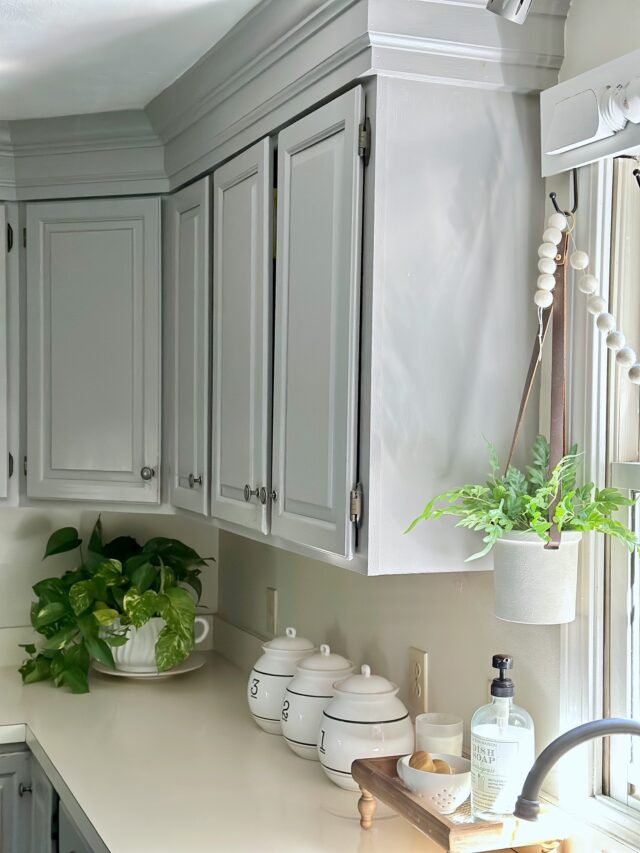
Content may contain affiliate links. When you shop the links, we receive a small commission at no cost to you. Thanks for supporting my small business.
Jump to:
- The magic formula: Specialty products do the heavy lifting
- Why this painting process works
- The cost
- Determining how much paint and primer you will need
- Navigating tannins and white paint
- A foolproof 2-primer system for light-colored paint on wood cabinets
- Mastering the art of light-colored cabinet painting
- Our recommended 3-step process
- Materials needed
- Expert application tips & techniques
- Style ideas for painted cabinets
- Upgrading cabinet hardware: Hinges and knobs
- Brush, roller, or spray: Choosing your application method
- Creating an organized DIY painting area
- Step by step instructions
- Staying safe while painting
- Whether to paint your cabinet interiors
- Caring for your painted cabinets
- Frequently asked questions
With advice from our local painting experts, we found a cleaner, primer and paint that allowed the new color to adhere smoothly to the wood with no sanding. It just took some patience and determination to not cut corners. I can't wait to show you how we turned our dated oak cabinets into beautiful modern grey showstoppers on a budget.
If our decades-old kitchen can get an upgrade, I promise yours can too! With a few simple preparation steps recommended by professionals and the transformative power of today's painting products, it's easier than ever to ditch heavy refinishing and save energy while reviving your old cabinets.

The magic formula: Specialty products do the heavy lifting
When searching for the best paint for cabinets without sanding, look no further than Benjamin Moore Advance. With its smooth application and durable finish, Advance delivers exceptional results. However, pairing it with two other specialized products elevates this paint to an even higher level for flawless cabinet transformations. We discovered that by using Advance Paint in combination with Dirtex Cabinet Cleaner and Benjamin Moore Stix Primer, we could achieve stunning outcomes without tedious sanding or stripping. The cleaner, primer, and Advance paint work harmoniously together, allowing for ideal adhesion and coverage when painting cabinets. Based on our cabinet refinishing experience, this triple threat of products made all the difference, acting as true game-changers. The Dirtex deep cleans, Stix bonds tenaciously to surfaces, and Advance levels smoothly - no sanding necessary. This systematic process revolutionizes painting cabinets for a polished look that lasts. Based on our personal experience, these game-changing products made all the difference for us:
Dirtex Cleaner - This heavy-duty degreaser removes residue for the cleanest surface for painting. No residue and no need to sand when the grime is gone!
Benjamin Moore Stix Primer - With incredible adhesion power, this primer bonds tight to surfaces like oak and maple without sanding or stripping. It tackles tough stains and smooths texture and is the best primer to use with Benjamin Moore Advance Paint.
Benjamin Moore Advance Paint - This high-quality waterborne alkyd paint levels smoothly for flawless results. With various sheens like trendy satin, it offers a modern finish that wears like iron over its specially formulated primer. Designed specifically for doors, trim, and cabinetry, this paint offers optimal performance and a flawless finish. In our opinion, Benjamin Moore Advance Paint is the best cabinet paint around for DIYers! We chose a beautiful Grey color you can read about this choice in this The Best Grey Kitchen Cabinet Paint Colors Revealed post.
I'll explain why these three products paired together help anyone paint wood cabinets for a long-lasting transformation without the hassle of sanding or temporarily losing kitchen function. No need to demolish your hearth and home when strategic cleaning, priming and painting do the job!
Click to find a Benjamin Moore retailer in your area. We purchase ours from Hopkinton Lumber, Hopkinton, MA.

Why this painting process works
What makes this painting process so revolutionary is using specialty formulas that eliminate the need for labor-intensive sanding and stripping. The degreaser, primer, and paint work seamlessly together to prep, adhere to, and cover wood surfaces without removing material first.
This saves enormous time, effort, dust, and allows your kitchen to remain fully functional amidst the project. No need to empty cabinets or cook meals elsewhere! These convenient products make upgrading cabinets simple by sticking tight to raw wood for a smooth, lasting finish. Let the cleaner, primer and paint combination transform even the most outdated oak to beautiful new life. Wave sandpaper goodbye!
The cost
The cost of painting kitchen cabinets using Benjamin Moore Stix primer and Advance paint can vary based on factors such as the size of the kitchen, the number of cabinets, and the quality of brushes and rollers used. Here's a rough estimate:
- Dirtex Multi-surface Cleaner (18 oz): $5 - $10
- Benjamin Moore Stix Primer (1 gallon): Approximately $50 to $70.
- Benjamin Moore Advance Paint (1 gallon): Around $50 to $70.
- Quality brushes and rollers: $20 to $40, depending on the brand and type.
Keep in mind that these are approximate prices, and they can vary based on your location, the specific product variations, and any additional tools or materials you might need (such as sandpaper, painter's tape, or drop cloths). Additionally, if you decide to hire a professional painter, labor costs will add to the overall expense. It's recommended to obtain quotes from local suppliers and professionals for a more accurate estimate tailored to your specific situation.
Determining how much paint and primer you will need
Determining how much paint is needed for a project, such as painting kitchen cabinets, involves calculating the total square footage of the surfaces you plan to paint. Here's a general guide on how to estimate the amount of paint required:
- Measure Cabinet Surfaces:
- Measure the height and width of each cabinet door and drawer front.
- Calculate the square footage of each by multiplying the height by the width.
- Add up the square footage of all doors and drawer fronts.
- Measure Cabinet Frames:
- Measure the height and width of the cabinet frames.
- Calculate the square footage of each frame component (sides, top, and bottom).
- Add up the square footage of all frame components.
- Calculate Total Square Footage:
- Add the square footage of doors/drawer fronts to the square footage of frames to get the total square footage of the cabinets.
- Consider Coverage Rate:
- Check the coverage rate of the paint you're using. This is usually indicated on the paint can and is given in square feet per gallon.
- Divide the total square footage by the coverage rate to determine the number of gallons needed.
Formula:
Gallons Needed=Total Square Footage/Coverage Rate (Sq. Ft./Gallon)
Keep in mind that you may need more than one coat, especially for cabinets, which require a primer and 2 layers of paint for a smooth finish. Factor in these additional coats when estimating the amount of paint needed.
Always check the specific recommendations on the paint can and consult with the paint store for advice tailored to the product you're using and the conditions of your cabinets. It's better to buy a bit more paint than strictly needed to account for potential variations and touch-ups.

Navigating tannins and white paint
Tannins are natural substances found in wood, and they can pose a challenge when painting wood furniture or cabinets white. Tannins can bleed through paint, causing yellowish or orangish stains on the surface. This is particularly noticeable when using light-colored or white paint, as the stains can discolor the finish. To address this issue, a primer with stain-blocking properties, such as Zinsser BIN Shellac-Based Primer, is often recommended. This primer creates a barrier that prevents tannins from seeping through the paint, ensuring a clean and even finish, especially when dealing with wood types that are rich in tannins, such as oak.

A foolproof 2-primer system for light-colored paint on wood cabinets
While my 3-step painting process works beautifully for most cabinet types, I want to highlight one potential hiccup that comes up when dealing with wood containing tannins. While using darker paint colors for oak and other tannin-rich woods stained cabinets, bleed-through likely won't be noticeable. However, if you're painting over wood grain with very light or white paint, you'll want to test for any discoloration seeping into your fresh priming job. No worries, you can still get a beautiful finish by using a combo of Stix water-based bonding primer first, followed by oil-based BIN shellac primer if needed, you can still stick to a simplified process while ensuring stubborn stains won't wreck your efforts. Keep reading and I'll walk through indicators to test for tannins, and this 2-primer system that keeps things headache-free!

Mastering the art of light-colored cabinet painting
The key is to start by applying Benjamin Moore Stix Water-Based Bonding Primer to the clean wood. This versatile primer excels at helping paint adhere properly. Let the Stix primer dry completely, then inspect closely for any yellowish or orangish stains bleeding through - these would indicate tannins in the wood.
If no stains appear, you are clear to go ahead with a second coat of Stix (for extra coverage under the light color paint) then move to applying your topcoat paint (two coats)! However, if you do see discoloration, take the extra step of coating the Stix primer with a layer of Zinsser BIN Shellac-Based Primer. BIN acts as an impermeable barrier, blocking those pesky wood stains from showing through your final paint.
While BIN adds an extra priming step if tannins are present, this strategic system eliminates the need to double prime every cabinet. By using both Stix and BIN if discoloration occurs, you get the adhesion of Stix combined with stain blocking where needed - efficiently optimizing the preparation process. Targeted troubleshooting ensures a simplified yet successful paint job! You can read more about troubleshooting tannins visit my How to Paint Furniture White post.

Our recommended 3-step process
Embark on your cabinet transformation journey with this step-by-step process, ensuring a seamless and professional finish:
- Cleaning - Dirtex Cleaner: Start by thoroughly cleaning the cabinet surfaces with a high-quality cleaner like Dirtex. This step removes grease, grime, and other contaminants, providing a clean canvas for the upcoming transformations.
- Priming - Stix Primer Application: Apply a coat of Stix primer to create an optimal surface for paint adhesion. Stix primer is renowned for its bonding capabilities, ensuring that the paint adheres securely and delivers a lasting finish.
- Painting - Advance Paint in Satin Sheen: Utilize Benjamin Moore Advance paint in a satin sheen for a smooth and durable finish. Whether using brushes, rollers, or a combination, take advantage of the self-leveling properties of Advance paint to achieve a flawless appearance.
Follow this systematic process to revitalize your cabinets, creating a stunning and long-lasting impact in your kitchen or any other space.
Note: You may need a 4th step if painting your cabinets white or another light color. See Navigating Tannins and White Paint above.

Materials needed
Gather the essential materials for your cabinet painting project to ensure a smooth and successful transformation:
- Dirtex Cleaner: Begin with a reliable cleaner like Dirtex to thoroughly clean and prep the cabinet surfaces, eliminating any dirt or grease.
- Benjamin Moore Stix Primer: Invest in Benjamin Moore Stix Primer for its exceptional bonding properties, providing a solid foundation for the paint to adhere to.
- Benjamin Moore Advance Paint: Opt for Benjamin Moore Advance paint, known for its self-leveling characteristics and durable satin sheen, delivering a professional finish.
- Paintbrushes, Rollers, Trays: Equip yourself with high-quality paintbrushes, rollers, and trays for efficient and effective application of both primer and paint.
- Painter’s Tape: Ensure clean and precise lines by using painter's tape to protect areas not intended for painting.
- New Hardware (Optional), Screwdriver: Consider updating the look with new hardware (if desired) and have a screwdriver on hand for installation.
- Saw Horses Setup: Set up two ladders or saw horses with a board between them to create a DIY paint station for your cabinet doors.
- Drop Cloths: Prepare your painting area by laying down drop cloths to protect the surrounding space from any accidental spills or drips.
With these materials in hand, you'll be well-equipped to embark on your cabinet painting project and achieve professional-looking results.
Expert application tips & techniques
When transforming your cabinets without the hassle of sanding, mastering the application is key. Explore these expert tips and techniques to achieve a flawless finish:
- Brushwork Brilliance:
- Optimize your brushwork technique, focusing on minimizing strokes for a smooth and even surface.
- Benjamin Moore Advance, known for its leveling properties, enhances the paint's ability to settle evenly, ensuring a professional result.
- Drip-Free Excellence:
- Avoid unsightly drips by laying cabinet doors and drawer fronts flat during the painting process.
- This simple step minimizes the risk of drips, allowing the paint to self-level and maintain a pristine appearance.
- Mastering Drying Times:
- Patience is key. Allow ample drying time between coats to prevent smudging and ensure a durable, long-lasting finish.
- Follow the recommended drying times for Benjamin Moore Advance, maximizing the paint's performance and longevity.
Elevate your cabinet-painting project with these application insights, making the process efficient and the results impeccable. Your cabinets will thank you with a renewed and stylish appearance.

Style ideas for painted cabinets
- Color Suggestions:
- Explore a spectrum of possibilities with Benjamin Moore's extensive color palette. From timeless neutrals to bold hues, find the perfect paint color to complement your kitchen's aesthetic.
- Consider classic whites for a fresh, clean look or venture into rich, moody tones for added sophistication.
- Contrasting Island:
- Make a statement by painting your kitchen island in a contrasting color. This not only adds visual interest but also creates a focal point in the heart of your kitchen.
- Experiment with pairing light cabinets with a bold, jewel-toned island or vice versa for a dynamic and balanced appeal.
- Accent Walls or Trim:
- Extend the impact of your cabinet transformation by incorporating accent walls or trim in coordinating colors.
- Use accent colors strategically to highlight architectural features or create visual interest along with trim and molding.
Transform your entire kitchen into a stylish haven with these color-focused style ideas. Whether you prefer a cohesive palette or bold contrasts, these suggestions will elevate your space to new design heights.

Upgrading cabinet hardware: Hinges and knobs
When embarking on a cabinet painting project, the decision to replace or retain existing hardware, such as hinges and knobs, plays a crucial role in achieving the desired aesthetic. Here are some considerations for upgrading cabinet hardware:
- Assessing the Condition:
- Evaluate the current condition of hinges and knobs. If they are in good shape and complement the new design, keeping them can be a cost-effective option.
- Replacing Hinges or Knobs:
- If opting for new hardware, ensure the replacement hinges or knobs are of the same size and type as the existing ones. Mismatched hardware can affect functionality and appearance.
- Filling Holes and Sanding:
- When replacing hardware with different dimensions, holes from the previous fixtures may not align. In such cases, filling the existing holes with wood filler is necessary. Sand the filled areas to create a smooth surface before applying primer.
- Priming Over Knob or Hinge Holes:
- Apply a high-quality primer, like Benjamin Moore Stix, over the filled and sanded areas. This ensures proper adhesion of both the filler and subsequent coats of paint.
- Choosing the Right Hardware:
- Selecting new hinges or knobs provides an opportunity to update the overall style of the cabinets. Choose hardware that complements the kitchen's aesthetic, whether it's modern, traditional, or transitional.
- Uniformity in Design:
- For a cohesive look, ensure uniformity in the design and finish of the chosen hardware. Consistency in hardware style contributes to a polished and harmonious cabinet appearance.
By carefully considering whether to replace or retain cabinet hardware and addressing any changes in size, you can enhance the visual appeal of your cabinets while maintaining functionality. This step adds a personalized touch to your kitchen transformation.

Brush, roller, or spray: Choosing your application method
While a paint sprayer finish boasts exceptional smoothness, it comes with a learning curve, additional costs, and the need for meticulous masking. If you prefer a more hands-on approach, high-quality brushes and rollers provide a versatile solution.
Invest in a reliable 3- to 4-inch-wide square brush for efficient coverage on large, flat panels, and add an angled brush in the 2½- or 3-inch-wide range for corners and door frames. Opt for a synthetic bristle brush when applying latex paint and a natural-bristle brush for oil-based paint. The self-leveling properties of Benjamin Moore Advance paint ensure a professional finish, whether you choose a brush or roller. Rollers can be particularly efficient for both primer and paint application, offering a comfortable alternative based on your preference and comfort level. This approach not only streamlines the painting process but also accommodates your comfort and expertise, ensuring a successful cabinet transformation.

Creating an organized DIY painting area
To ensure a seamless cabinet-painting process, designate a specific space for your project, as it may span several days. Set up a DIY paint station using two ladders (or two sawhorses) with a board placed between them, providing an ideal surface for laying cabinet doors. Implement a routine of painting, allowing to dry, flipping, repeating the process, and ensuring ample drying time between coats. Do a little prep work by placing drop cloths to protect your surroundings and streamline cleanup, ensuring a well-organized and efficient painting experience.

Step by step instructions
Step 1: Gather materials
Use painter’s tape to protect areas you don’t want to paint, such as walls and countertops. This ensures clean and precise lines.
Before you start, ensure you have all the necessary materials and tools:
- Dirtex cleaner
- Benjamin Moore Stix Primer
- Benjamin Moore Advance paint (we recommend satin finish)
- Paintbrushes, rollers, trays
- Painter’s tape
- New hardware (optional)
- Screwdriver
- Saw horses setup
- Drop cloths
Step 2: Set up your DIY paint station
The next step is to set up a designated painting area using two ladders (or saw horses) with a board between them. This setup allows the cabinet doors to lay flat for easy painting, drying, flipping, and painting again. Lay down drop cloths to protect the surrounding space.
Step 3: Remove cabinet doors and hardware
Take off the cabinet doors and remove any hardware. If you plan to replace the hardware, now is the time to do so. Keep track of screws and hardware to ensure easy reinstallation and be sure to make a diagram of the cabinets, numbering each cabinet door and drawer front. Before you remove the cabinet doors and drawer fronts, tape the corresponding numbers to them - trust me you don't want to miss this step!

Step 4: Clean the surfaces
Clean the cabinet surfaces thoroughly with Dirtex cleaner. Starting with clean cabinets is crucial to remove grease, dirt, and any residues that may affect paint adhesion. Follow the directions on the can for best results.

Step 5: Tape and protect
Before starting the painting process, use painter's tape to protect surrounding areas like walls, countertops, floors, and ceilings. Strategic taping prevents paint from getting on surfaces not intended for transformation. It allows you to maintain clean lines and aids in a neater painting experience.
Step 6: Apply Stix Primer
Using a paintbrush, apply a coat of Benjamin Moore Stix Primer to the cabinet surfaces. The primer provides excellent adhesion and prepares the cabinets for the paint. Allow the coat of primer to dry according to the product instructions.

Step 7: Choose your application method
Decide whether you'll use a paintbrush, roller, or a combination of both for the primer and paint application. Benjamin Moore Advance paint has self-leveling qualities, making it suitable for various application methods.
Step 8: Paint with Benjamin Moore Advance
Apply the top coat of Benjamin Moore Advance paint in your chosen sheen (satin is a popular choice for cabinets). Work methodically, avoiding drips and ensuring even coverage. Allow the first coat to dry completely before applying a second coat.
Tip: Always go back and thoroughly check raised panel cabinet doors for any paint drips or puddling that may have collected unnoticed in the recessed grooves or corners after drying.

Step 9: Detailing and final touches
Once the paint is dry, reattach the cabinet doors and add any new hardware if desired. Perform any final detailing or touch-ups as needed.
Step 10: Allow for proper drying
Let the cabinets cure and harden for several days before reinstalling them in your kitchen. This drying process ensures a durable and long-lasting finish.
With these step-by-step instructions, you can achieve a professional-looking cabinet transformation without the need for sanding.

Staying safe while painting
While transforming your space with paint can be an exciting process, it’s important to keep safety top of mind when working with chemical products like cleaners, primers and paints. Here are some tips:
Personal Protective Equipment - Wear safety goggles, paint-resistant gloves, and an appropriate face mask or respirator while cleaning, priming and painting. Ensure adequate ventilation by opening windows and doors.
Read All Labels & Directions - Carefully review product labels and follow instructions for safe use. Never mix chemical products unless specifically stated as safe to do so.
Avoid Prolonged Skin Contact - Limit direct skin exposure to paints and solvents by keeping gloves and protective clothing on. Take breaks as needed.
Proper Disposal - Allow liquid waste including rinse water from cleaning brushes to fully solidify before disposal. Safely discard empty cans according to your local regulations.
Practice Caution Around Children & Pets - Keep kids and animals out of the designated painting workspace for their safety and wellbeing.
By taking appropriate safety measures, you can focus on enjoying the creative process while minimizing risks! Let safety guide you to success.
Whether to paint your cabinet interiors
Deciding whether to paint both the inside of your cabinets and cabinet doors involves considering various factors. Here are some points to help you make an informed decision for your cabinet painting project:
1. Visible Interior:
- Consideration: If the inside of your cabinets is highly visible or if you have glass-front cabinets, painting the interior can enhance the overall aesthetic appeal.
- Our Approach: We opted to paint both sides of the cabinet doors for a cohesive look, especially since the interior was partially visible through glass panels.
2. Usage and Functionality:
- Consideration: If you frequently open your cabinets and the interiors are regularly visible, painting the inside may be worth the effort.
- Our Approach: Since the insides of our cabinets were less visible in our kitchen layout, we chose to prioritize the exterior surfaces for a more efficient painting process.
3. Time and Effort:
- Consideration: Painting the inside of cabinets can be time-consuming, requiring meticulous taping and additional care.
- Our Approach: To streamline the process and save time, we focused on achieving a flawless finish for the exterior, leaving the interior unpainted.
4. Consistency with Design:
- Consideration: Consistency in design may influence your decision. Evaluate whether a uniform color inside and out aligns with your design vision.
- Our Approach: We found that maintaining consistency on the exterior provided the desired visual impact, while leaving the interior unpainted didn’t compromise the overall aesthetic.
5. Budget Constraints:
- Consideration: Painting both sides of doors and cabinet interiors may incur additional costs for paint and time.
- Our Approach: Considering our budget and the layout of our kitchen, we chose to allocate resources to areas with a more significant visual impact.
6. Personal Preference:
- Consideration: Your personal preference plays a significant role. If you have a strong desire for a completely finished look inside and out, it might be worth the investment.
- Our Approach: We prioritized a cohesive exterior look, aligning with our design preferences and the overall functionality of our kitchen.
The decision to paint the inside of your cabinets and cabinet doors depends on various factors, including visibility, functionality, time, budget, and personal preference. Assessing these aspects will guide you in making the right choice for achieving the desired outcome in your kitchen.

Caring for your painted cabinets
Now that you’ve put in the work to beautifully transform your cabinets, you’ll want them looking fresh for years to come. Here are helpful tips for maintaining your painted cabinets:
- Allow a full 30 days for the paint to fully cure and harden before cleaning. Use only soft, damp cloths during the curing period.
- For regular cleaning, use a mild soap and water solution with soft cloth. Avoid abrasive cleaners or scrub pads.
- Immediately wipe up spills and splatters to prevent staining.
- Reapply a fresh coat of paint every 2-3 years or whenever you notice fading or yellowing. Lightly sand and spot prime as needed between new coats.
- Check for any cracking or peeling annually and address right away before it spreads.
- Consider adding cabinet doors/drawer bumpers to prevent chipping from banging into each other.
Putting in minimal regular care protects your painted finish, maintains the freshly transformed look, and extends the life of your new kitchen as a whole. With just simple maintenance tips, you can enjoy your updated space for years of cooking and creating memories!

Frequently asked questions
You can paint cabinets with the doors and drawers attached, but it is highly recommended to remove them for the most professional results. Removing them provides easier access to all surfaces and prevents paint buildup along edges.
Most contents can remain in place during painting unless you plan to paint the insides of your cabinets. Here's what ours looked like while painting. 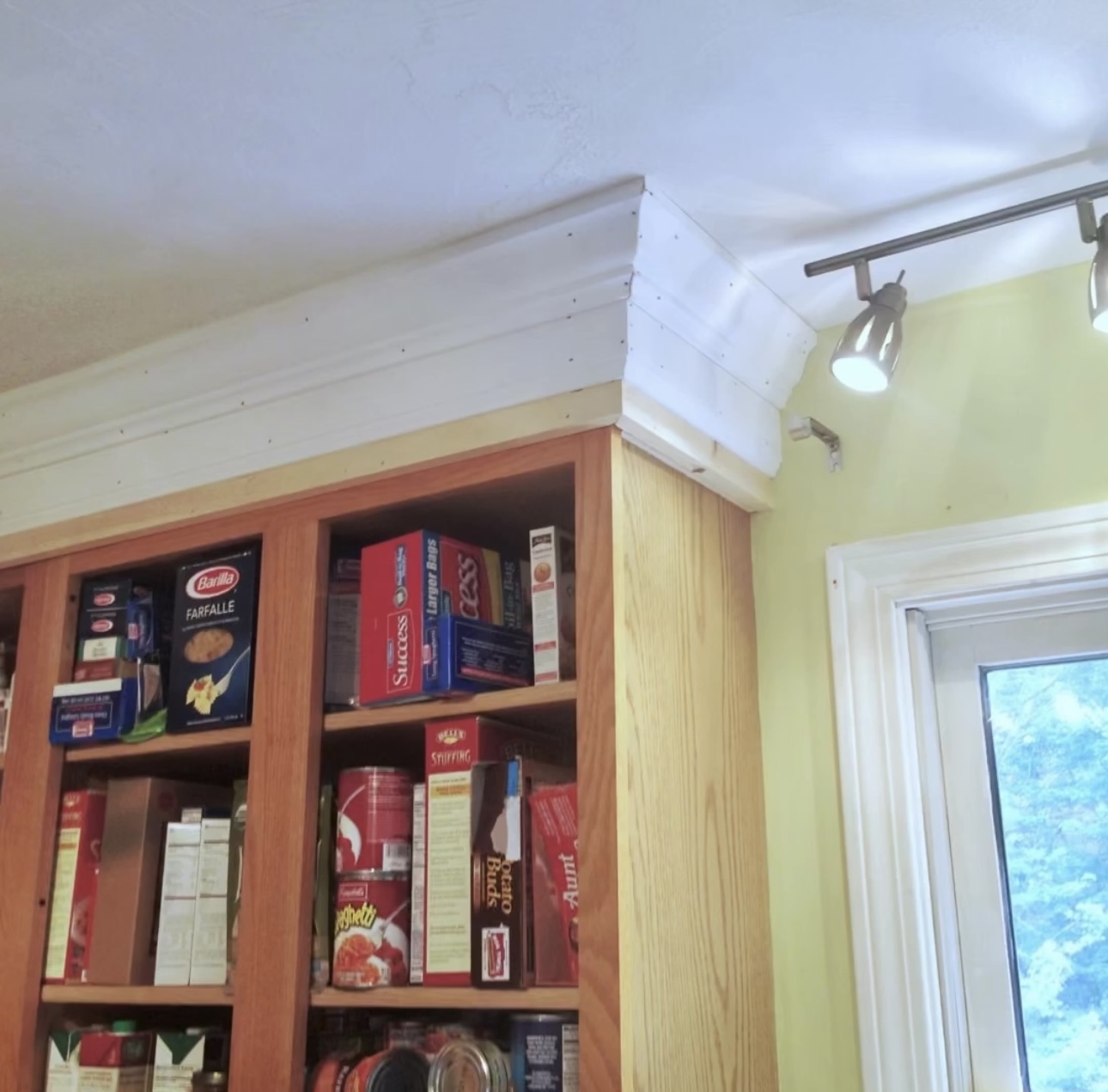
For best results without sanding, these specific products are recommended by professionals to work together. These products have stood the test of time in our kitchen.
Once fully cured in 5-7 days, cabinets are ready for regular use and cleanup.
For dark surfaces, consider applying an additional coat for optimal coverage. The use of a high-quality primer like Benjamin Moore Stix is essential to enhance coverage.
Allow ample drying time between coats. Typically, Benjamin Moore Advance Paint requires 16 hours of drying time before recoating. For the best end result ensure the surface is completely dry and free from tackiness before applying the next coat.
Absolutely! The paint process outlined is suitable for laminate cabinets, ensuring a durable and attractive finish. Just be sure to clean the laminate thoroughly, use a good primer like Benjamin Moore Stix, and choose a paint suitable for laminate surfaces like Benjamin Moore Advance paint. Follow the step-by-step guide, and you'll transform your laminate cabinets with ease.
When a paint is described as a "leveling paint," it means that the paint can smooth out and minimize the appearance of brush marks, roller stippling, or other texture irregularities as it dries. Leveling paints are designed to create a more even and uniform surface, resulting in a professional-looking finish. This property is particularly advantageous when painting surfaces like cabinets, where a smooth and flawless appearance is desired.
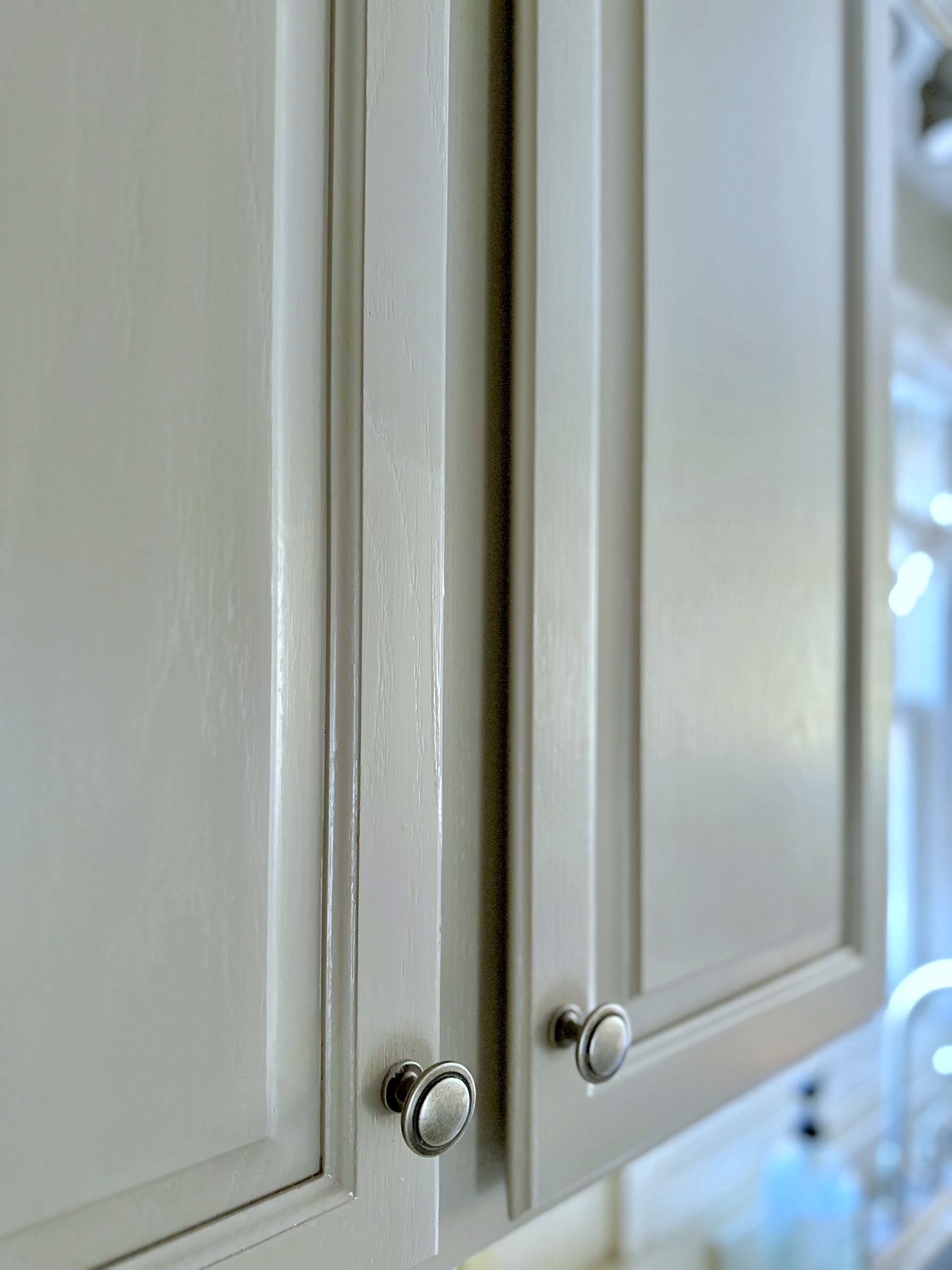
In this post, we've covered the essential steps to embark on your cabinet painting journey. From cleaning to priming and finally applying that transformative coat of Benjamin Moore Advance paint, your kitchen is on the brink of a stunning makeover.
If you're curious about product recommendations, you can find them at your local hardware store or major retailers like Benjamin Moore. Don't forget to check online platforms like Amazon for convenient purchasing.
For more kitchen inspiration visit:
How Far Should Kitchen Island Be From Cabinets? (Ideal Measurements and Layout Examples): The article provides recommended guidelines and measurements for proper kitchen island spacing and clearance. It covers minimum clearances of 36-42 inches on all sides, sizing the island to 10% of total kitchen square footage, allowing 28-30 inches per seat, and setting bar-height at 42 inches. Tips are included for incorporating islands in small kitchens, placement strategies around appliances, lighting, ventilation and upper cabinets. Common island planning mistakes are outlined.
A Kitchen Island Made from Base Cabinets: The popular post outlines how the author repurposed a free bathroom vanity cabinet into a custom, budget-friendly kitchen island. It covers the process of preparing the space, modifying the cabinetry, painting, adding hardware and a butcher block top. Extra tips are provided on using a second vanity for more storage. The goal is to demonstrate an innovative DIY kitchen island idea using recycled materials. Photos and FAQs illustrate the step-by-step building process to inspire readers to create their own affordable island transformation.
I hope you found this guide helpful and inspiring for taking on a kitchen cabinet painting project. Please let me know if you have any questions as you embark on your cabinet transformation journey. I would be happy to provide any additional tips or insights based on my experience painting our kitchen. Feel free to reach out at any point in the process. Wishing you the best of luck with revitalizing your space with a fresh coat of paint!
Happy painting friends!
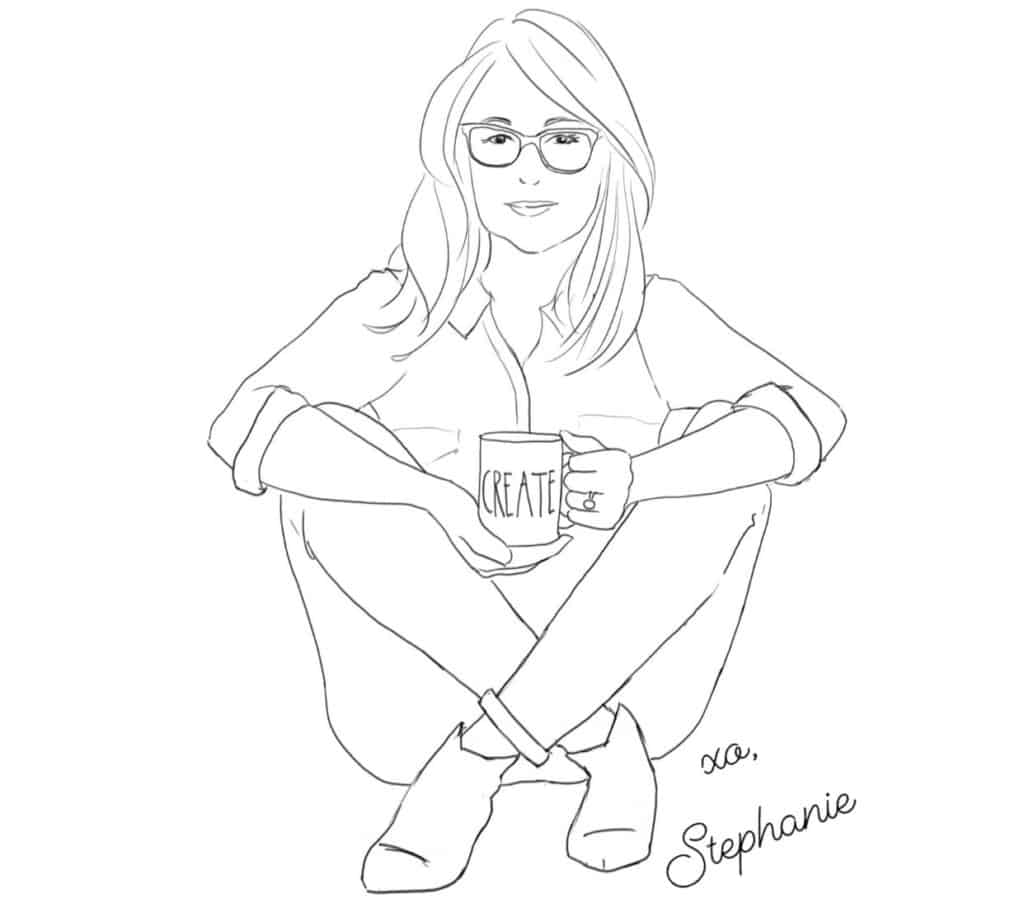

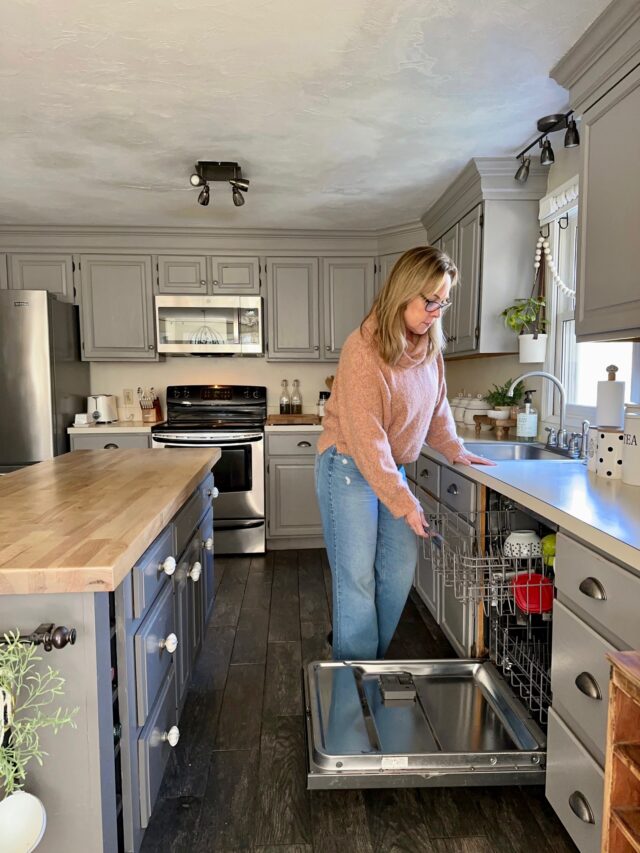
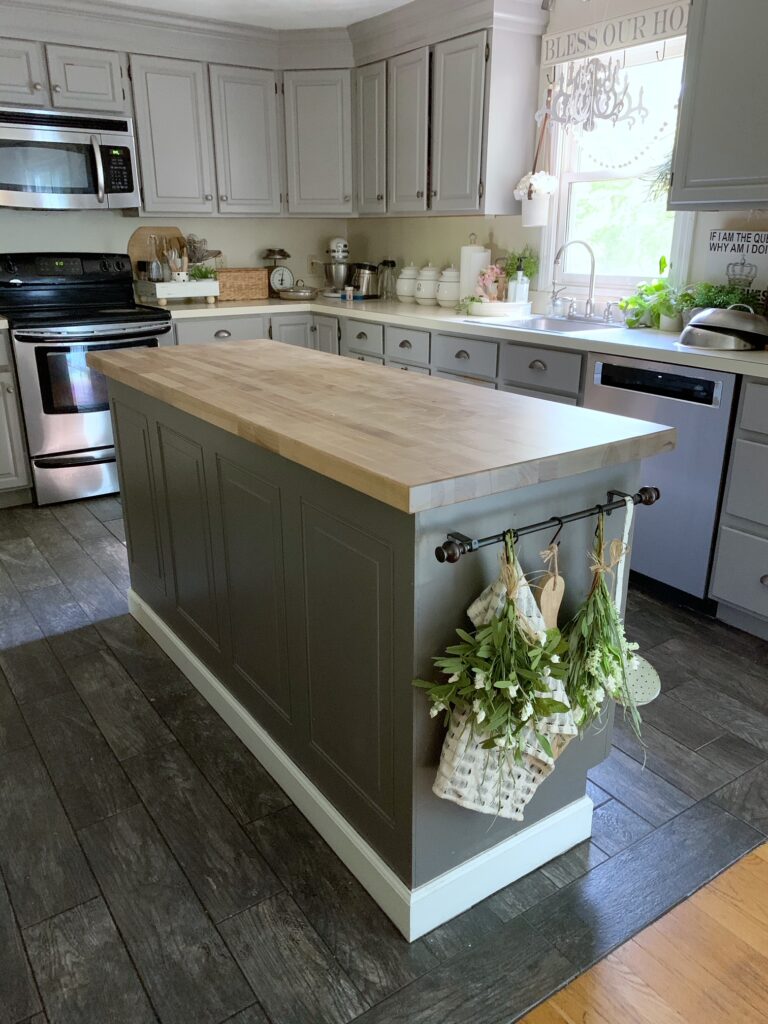






Heavily cooked in kitchens where there is grease build ups. What's your recommendation for that? Ive found that even with your recommendations for products of cleaning and priming there is still paint separation that occurs and especially in oak fronted cabinets
Hi there! Thanks for reaching out. Im surprised to hear this. These are excellent products and typically the steps I laid out work perfectly! I would check with your local paint supplier and see if a topcoat would be helpful. Perhaps another coat of BM Advance followed by a top coat? If the cabinets are white just be careful with oil based poly as it can turn yellow over time.